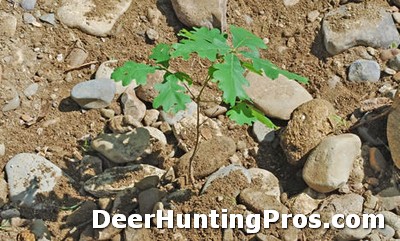There are many ways to make whitetail deer hunting on your property or hunting lease better. Whitetail are the most popular big game animal in North America, so it should come as no surprise that hunters are always trying to find habitat management practices that can make the deer on their lands bigger and healthier. One way to provide additional food for whitetail is by planing trees for deer.
For those of hunters that have been considering plant fruit, nut, or various other tree types to support the wildlife on your property, remember that between mid-November and mid- to late February is the time to plant if you’re doing seedlings.When the trees are in dormant state, they react more favorably to replanting. This allows them to set up their roots over the winter to some extent, making them ready for warmer weather and spring rains. This is also when food is most abundant for deer, so browsing pressure on your new tree should be lower.
In fact, you do not want any browsing pressure by deer on your newly-planted tree for some time, because any removal of foliage will cause the tree to stunt or even die. Hey, successful habitat management takes planning! Because you are trying to provide stuff that deer eat (just not immediately), you may have to protect the planted seedlings by placing them in tree tubes or by stacking brush around them so that they can establish. Whitetail deer can easily kill trees by over-browsing, and bucks love to use saplings when creating rubs.

This past fall, I went ahead and ordered 20 persimmon, 20 wild pear, and 20 live oak trees on our ranch and will also plant some of the leftover pecan seedlings I have from last year. This are great browse trees not only for their leaves, but because of the mast that they produce. Learn what deer eat in your area, in addition to what will grow, then plant the snot out of it. Deer love both the leaves and the mast of every species I have planted, so it will yield a lot of bang for the buck… literally!
When I planted last year, I used homemade cages from chicken wire and stakes I bought at home depot. This year, I bought some plantra/tubex combo tree tubes to try out. Everything I’ve read on them suggests that using tree tubes massively increases the rate of growth in seedlings. I only bought 25, so I’ll probably due 5 of each tree variety and use some of the cages I have from last year where the seedlings died anyway.
If anyone is planting trees in an area that has a decent deer population and is looking for the cheapest tree tubes, then I’d recommend Tree Protection Supply for the tubes and stakes. And no, I don’t work for them or really even know them for that matter. They don’t sell anything else (maybe some deer repellent), but they had the cheapest tree tubes I found on the internet. The total cost was around $100 with shipping included.
Okay, the tree tubes are not cheap, but in my area like many areas the deer and rabbits absolutely murder seedlings, so I’m going to use them. Trees provide a lot of value in many ways, so if you are going to go through the trouble of planting them then help ensure that they do the best that they can. Because if they survive and grow, you and your deer herd will reap the rewards.
My habitat management goal is to have my 180 acres absolutely loaded various fruits and nuts and browse to provide near year-round food for white-tailed deer and feral hogs. To date, I’ve planted Bur Oak, Sawtooth Oak, Chinkapin Oak, Jujube, 3 varieties of pear, Pecan, Persimmon, Mexican Plum, Wild Plum and even some honeysuckle. The pecan trees have done the worst. All the other trees have added significant growth in the first year—over a foot on average! Planting trees for wildlife is a long-term plan that will begin paying off in just a few years with fruits and mast for deer in my area. I expect some good deer hunting in the future, and some good eating from both the deer and the fruits too.